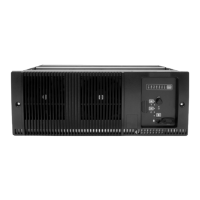74 Network Circuitry TB9100 Reciter Service Manual
© Tait Electronics Limited January 2006
and Zener diode D601, before passing through the customary EMC
filtering components.
Op amp U601 is powered from the +5V supply, so it only supports a 0V to
5V output range, as opposed to the 0V to 6.5V range for the standard analog
SIF board. This restriction is for compatibility with logic devices connected
to the RSSI output. Should the analog output function not be required, the
RSSI output can be used as a general-purpose logic level output. Transistors
Q603a and Q603b are controlled by parallel output lines PB22 and PB23
from the MPC and can be used to force the output high or low respectively.
Any high-speed logic device connected to this output should use Schmitt
trigger inputs to avoid oscillation, due to the relatively slow transition time
of U601’s output.
Note The RSSI output feature is not supported in all software versions.
5.6 Ethernet Interface
5.6.1 Ethernet Physical Interface
The FEC in the PowerQUICC does not incorporate the physical level
interface hardware for direct connection to an ethernet network, so an
ethernet PHY is required. This function is provided by U700, a 10/
100Mbps ethernet transceiver with twisted pair interface. This device, and
the FEC, are both capable of operating at either 10Mbps or 100Mbps, half
or full duplex, and may use auto negotiation.
The incoming signals on the ethernet receive twisted pair are coupled
through isolation transformer T700b and passed to the differential receive
data inputs, RXP and RXN, of U700. The line is terminated by resistors
R705 and R706, while excess voltage spikes are clamped to supply, or
ground, via diode array D700.
Differential outgoing signals, TXP and TXN, from U700 are also
transformer isolated through T700a before being transmitted to line. Line
termination is provided by R710 and R711, with overvoltage clamping
performed by D700. Common mode termination of the transmit and
receive pairs is provided by R712 and R713. Unused pairs in the ethernet
cable are terminated by R715 and R716 and connected to chassis ground
through C723, to minimize noise coupling to the active pairs.
U700 provides several LED driver outputs, LED0 through LED3, for
indicating the status of the PHY. LED0 output indicates whether the U700
is connected to a network and whether data reception or transmission is
taking place: flashing indicates reception or transmission, whilst steady
indicates a link has been established. LED3 output indicates whether a
collision has occurred during transmission.

